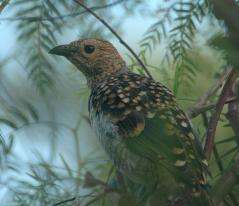May 11, 2011 report
Stress may explain vocal mimicry in Bowerbirds

(PhysOrg.com) -- Spotted Bowerbirds (Ptilonorhynchus maculatus) are best known for their nests, but these birds are also capable of mimicking the vocalizations of many different species of birds. It was believed bowerbirds were mimicking the sounds of predatory birds as a way of defense, but a new study in Naturwissenschaften determined that is not the case, but rather that stress and stressful situations account for the vocalizations they choose to mimic.
Dr. Laura Kelly from the University of St. Andrews led the team of researchers. Kelly has been studying the bowerbirds for some time, and just last year published a study in Biology Letters, “Vocal mimicry in male bowerbirds: who learns from whom?”
In this previous study, they looked at different male bowerbirds to determine if the male birds were learning their vocalizations from other male bowerbirds or from the direct species themselves. In studying 19 different male bowerbirds, they found that the males were not learning from other males, but rather directly from other bird species, as each bird mimicked the sounds in slightly different ways. In that study, Kelly believed that finding evidence that the bowerbirds learned from their environment was only the start and planned to find out why they mimic certain birds.
This brings us to the recent study published in Naturwissenschaften. While it was believed that these bowerbirds mimicked predators, Kelly and her team found that predator calls accounted for only 20% of the calls the birds had learned. They found the birds were mimicking sounds from “bully” species and aggressive birds, as well as alarms calls from other species.
From what the researchers determined, these birds mimic alarm and mobbing calls (sounds birds make when their areas are violated by predators) of the different species in their local environment. They believe the bowerbirds learn these vocalizations under stressed circumstances and later reproduce the sounds when they themselves are stressed. Kelly believes that this is the first study to suggest a possible link between stress and vocal mimicry.
More information: * The mimetic repertoire of the spotted bowerbird Ptilonorhynchus maculatus, Laura A. Kelley and Susan D. Healy, Naturwissenschaften, DOI: 10.1007/s00114-011-0794-z
Abstract
Although vocal mimicry in songbirds is well documented, little is known about the function of such mimicry. One possibility is that the mimic produces the vocalisations of predatory or aggressive species to deter potential predators or competitors. Alternatively, these sounds may be learned in error as a result of their acoustic properties such as structural simplicity. We determined the mimetic repertoires of a population of male spotted bowerbirds Ptilonorhynchus maculatus, a species that mimics predatory and aggressive species. Although male mimetic repertoires contained an overabundance of vocalisations produced by species that were generally aggressive, there was also a marked prevalence of mimicry of sounds that are associated with alarm such as predator calls, alarm calls and mobbing calls, irrespective of whether the species being mimicked was aggressive or not. We propose that it may be the alarming context in which these sounds are first heard that may lead both to their acquisition and to their later reproduction. We suggest that enhanced learning capability during acute stress may explain vocal mimicry in many species that mimic sounds associated with alarm.
* Vocal mimicry in male bowerbirds: who learns from whom? Laura A. Kelley and Susan D. Healy, Biol. Lett. 23 October 2010 vol. 6 no. 5 626-629 doi: 10.1098/rsbl.2010.0093
Abstract
Vocal mimicry is one of the more striking aspects of avian vocalization and is widespread across songbirds. However, little is known about how mimics acquire heterospecific and environmental sounds. We investigated geographical and individual variation in the mimetic repertoires of males of a proficient mimic, the spotted bowerbird Ptilonorhynchus maculatus. Male bower owners shared more of their mimetic repertoires with neighbouring bower owners than with more distant males. However, interbower distance did not explain variation in the highly repeatable renditions given by bower owners of two commonly mimicked species. From the similarity between model and mimic vocalizations and the patterns of repertoire sharing among males, we suggest that the bowerbirds are learning their mimetic repertoire from heterospecifics and not from each other.
© 2010 PhysOrg.com



















